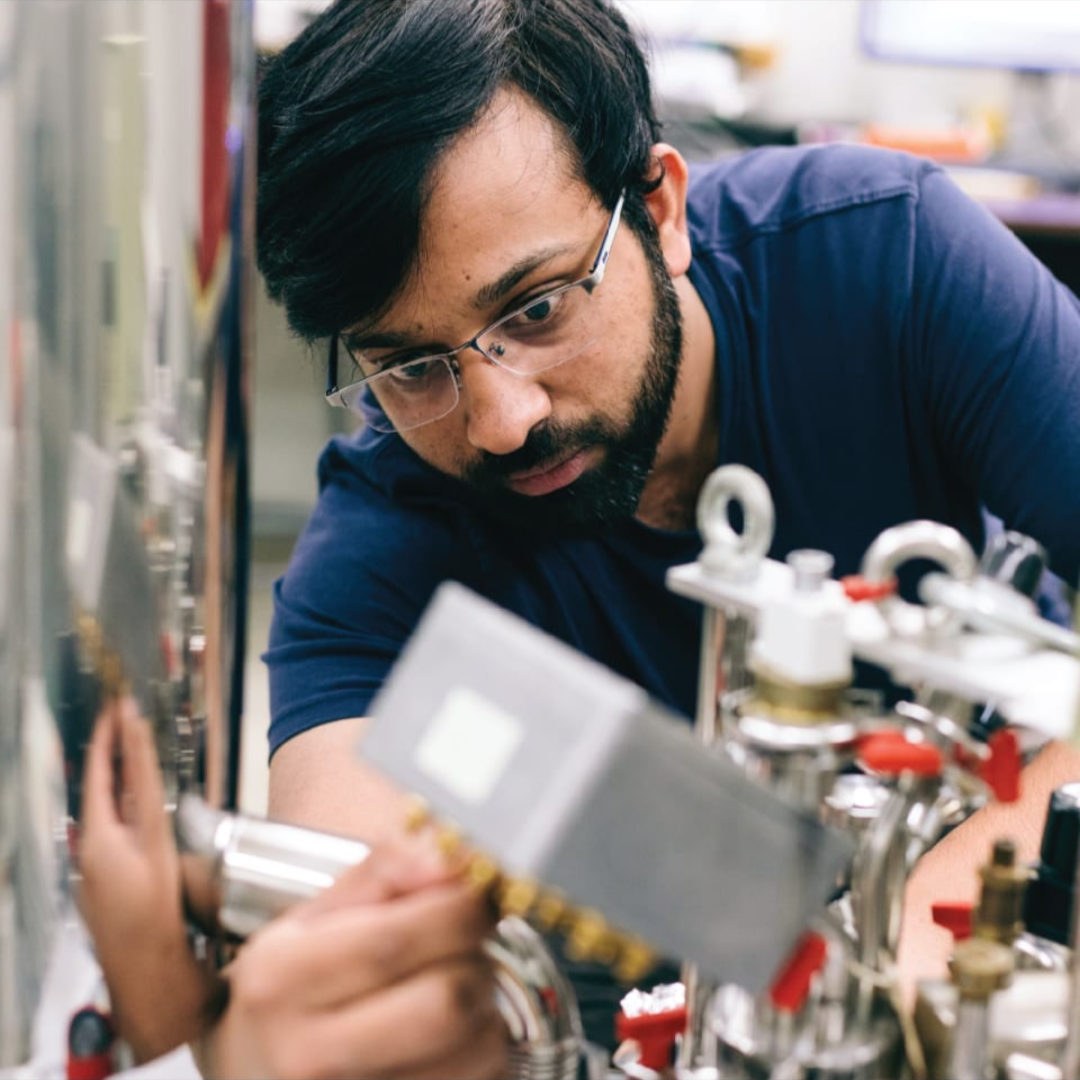A cool discovery: Purdue physics team uncovers new quantum state at record-low temperatures
2025-10-29

Waseem Hussain in Csathy’s laboratory performing magnetotransport measurements. (Photo by/Stephen Hustedt)
A Purdue University physics team has discovered evidence of a new quantum state of matter. This new state may deepen scientists’ understanding of how electrons organize in two dimensions as it supports highly unusual correlations with an exotic topological order.
When electrons are cooled to just a few thousandths of a degree above absolute zero, they begin to act in collective and unexpected ways. In a new study published in PNAS Nexus, researchers observed signatures of a previously unknown fractional quantum Hall ground state at a filling factor of 7/11, a ratio that defines how electrons fill discrete energy levels in a magnetic field.
This discovery, led by Gabor Csathy, professor and head of the Purdue’s Department of Physics and Astronomy, reveals a new form of topological protection, a hallmark of quantum materials with exotic electronic properties.
“In this study, we employed ultra-clean GaAs/AlGaAs samples and ultra-low temperature techniques and found the evidence of a novel quantum Hall ground state,” Csathy said. “This ground state is a candidate state to study correlations that are absent in other dozens of quantum Hall ground states.”
The Purdue team included Waseem Hussain and Haoyun Huang, both graduate students in the Department of Physics and Astronomy. Hussain performed magnetotransport measurements, analyzed the data and co-wrote the paper with Csathy. Huang also conducted magnetotransport experiments that were key to identifying the new state.
Their collaborators at Princeton University, Loren N. Pfeiffer, Kenneth W. West, and Kirk W. Baldwin, all in the Department of Electrical and Computer Engineering, produced and characterized the exceptionally pure GaAs/AlGaAs semiconductor samples used in the experiments. The samples, grown using molecular beam epitaxy, have record-high electron mobility, which was recently improved by about a factor of four in comparison to the previously available values, allowing researchers to explore more subtle and delicate quantum phenomena.
At Purdue, the researchers used advanced cooling systems to reach temperatures as low as 7.6 millikelvin (about –459°F). Under these extreme conditions, the team observed that electrons formed an ordered quantum state exhibiting “topological protection”, a property that stabilizes the system against disturbances.
The state at filling factor 7/11 is the particle-hole counterpart of another unusual state found at 4/11, long suspected to host unconventional correlations that go beyond the standard theoretical framework. Together, these states may offer clues to the emergence of special types of quasiparticles called anyons, whose properties are unlike anything seen in ordinary matter.
“Electrons confined to two physical dimensions and moving in a magnetic field are known to exhibit anyonic behavior,” Csathy said. “It is known that the anionic behavior is a result of the correlated motion of electrons, which manifests in environments with reduced disorder. We now know that the correlated motion of electrons leads to topological properties”.
Researchers worldwide are searching for topological states with novel topological order. Numerical simulations have shown that the topological order of the new 7/11 state is different from that of the most widely known fractional states, called Jain states. For this new state, there are exotic proposals based on both Abelian and non-Abelian anyons. The latter types of anyons form when a rare type of quantum correlation dominates. It is thought that anyons provide exciting new ways to advance quantum information research.
“By now, there are a large number of topological states realized,” Csathy said. “However, there are only a handful of such states with non-abelian degrees of freedom. Our work has uncovered a new state which is a candidate for hosting such non-Abelian degrees of freedom.”
The discovery was made possible by Purdue’s expertise in electronic cooling and precision measurements in high magnetic fields. “We have an ultra-low temperature setup based on Helium-3 immersion cell technology that allows us to reach the conditions where these new correlations appear,” Csathy said.
Low temperature transport measurements at Purdue were supported by the US Department of Energy Basic Energy Sciences Program under the award DE-SC0006671. Sample growth effort of Loren Pfeiffer at Princeton University is funded in part by the Gordon and Betty Moore Foundation’s EPiQS Initiative, grant GBMF 9615.01.
About the Department of Physics and Astronomy at Purdue University
Purdue's Department of Physics and Astronomy has a rich and long history dating back to 1904. Our faculty and students are exploring nature at all length scales, from the subatomic to the macroscopic and everything in between. With an excellent and diverse community of faculty, postdocs and students who are pushing new scientific frontiers, we offer a dynamic learning environment, an inclusive research community and an engaging network of scholars.
Physics and Astronomy is one of the seven departments within the Purdue University College of Science. World-class research is performed in astrophysics, atomic and molecular optics, accelerator mass spectrometry, biophysics, condensed matter physics, quantum information science, and particle and nuclear physics. Our state-of-the-art facilities are in the Physics Building, but our researchers also engage in interdisciplinary work at Discovery Park District at Purdue, particularly the Birck Nanotechnology Center and the Bindley Bioscience Center. We also participate in global research including at the Large Hadron Collider at CERN, many national laboratories (such as Argonne National Laboratory, Brookhaven National Laboratory, Fermilab, Oak Ridge National Laboratory, the Stanford Linear Accelerator, etc.), the James Webb Space Telescope, and several observatories around the world.
Written by: David Siple, communications specialist, Purdue University Department of Physics and Astronomy